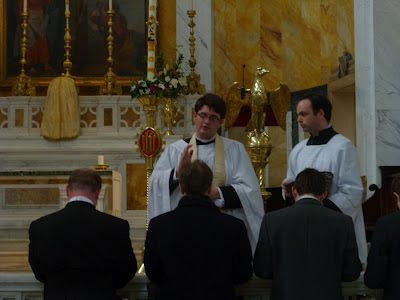Yesterday morning I went to London to attend the Chrism Mass for the Ordinariate of Our Lady of Walsingham which was celebrated by the Papal Nuncio, H.E. Archbishop Antonio Mennini, at St James Spanish Place.
The setting was splendid, there was a good line-up of priests in choir and the body of the church was filled by the laity as well as some non-participating priests.
The Papal Nuncio, the Ordinary and the clergy of the Ordinariate.
The photograph also indicates how splendid setting for the liturgy is the church.
Image: Ordinariate
The New Liturgical Movement blog has an illustrated report in
First Chrism Mass of UK Ordinariate at St. James, Spanish Place. The Ordinariate Portal has a link to a full set of photographs of the liturgy
here.
The Archbishop mixes the Chrism
Image:Ordinariate on Flickr/© Mazur/catholicnews.org.uk The Archbishop bestows the blessing at the end of Mass
Image: Ordinariate on Flickr/© Mazur/catholicnews.org.uk
Beforehand a friend had expressed the view that the Chrism Mass is merely a modern invention. Whilst it is true tht it is, in its present form, a product of the liturgical changes of the 1950s and 1960s, it is nonetheless a restoration of an ancient practice. My 1930s edition of the
St Andrew's Missal refers to its former existence. I assume that at some point the idea that there should only be one solemn Mass on Maundy Thursday, or sheer fatigue at the liturgical schedule, led to it being subsumed within the Bishop's Mass in his cathedral (or wherever he was celebrating Easter), accompanied by twelve priests, seven deacons and seven sub-deacons.
Reinstating a separate liturgy strikes me as a recovery of tradition rather than the invention of tradition. Once the ceremonies of Maundy Thursday moved back to the evening there are practical issues of time to determine events. In its present form, with the modern re-statement of priestly vows, it does serve to be a reaffirmation of priestly responsibility and duty, and, in a somewhat demotic way, by making it a public liturgy, brings that home to the laity as well.
In the context of the
novus ordo liturgy and the thought which inspired it this does seem an appropriate occasion for concelebration, as is indicated by the interview to which I linked in my recent post
Concelebration. The liturgy so celebrated does assert the unity of the local church around the bishop.
On the other hand it can equally well be argued, on a more traditionalist basis, that here, as elsewhere, concelebrants are not necessary at all, and that the key figure is the bishop as celebrant. Indeed it is important to stress the episcopal function as consecrator of the oils, that this is an hierarchical event, indeed a quintessentially one. The bishop is the mediator of the descent of Grace through tangible sacramental means, and requires no more than the appropriate traditional priestly and diaconal support.
Looking at the older liturgy I see that there, following the blessing of the oil of the sick, the oil of Chrism was consecrated first, and then the oil of the catechumens was blessed. The modern rite reverses this, concluding with the Chrism. This suggests an element of theatricality in the minds of the compilers, rather than adhering to the traditional order of proceeding, and is, I think, to be regretted.
So perhaps I favour restoring a separate Chrism Mass, but would favour a more traditional form, and indeed understanding of its theology.







 Young Mr Newman of Oriel
Young Mr Newman of Oriel